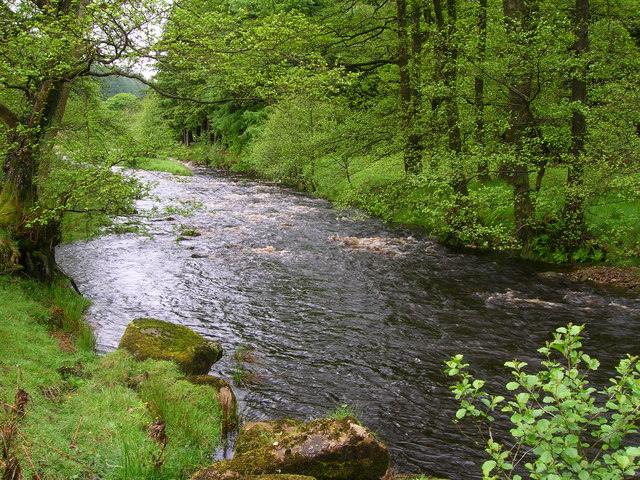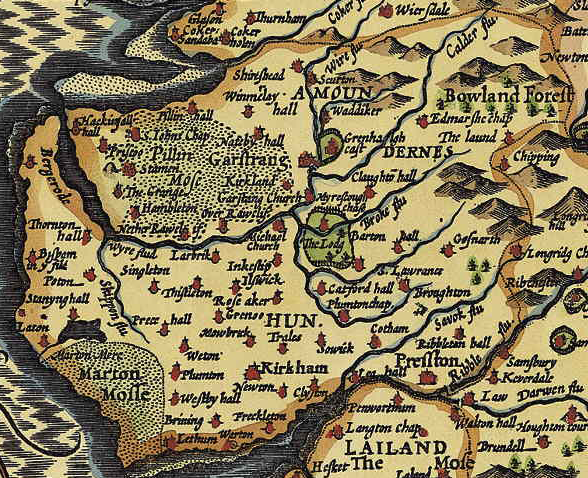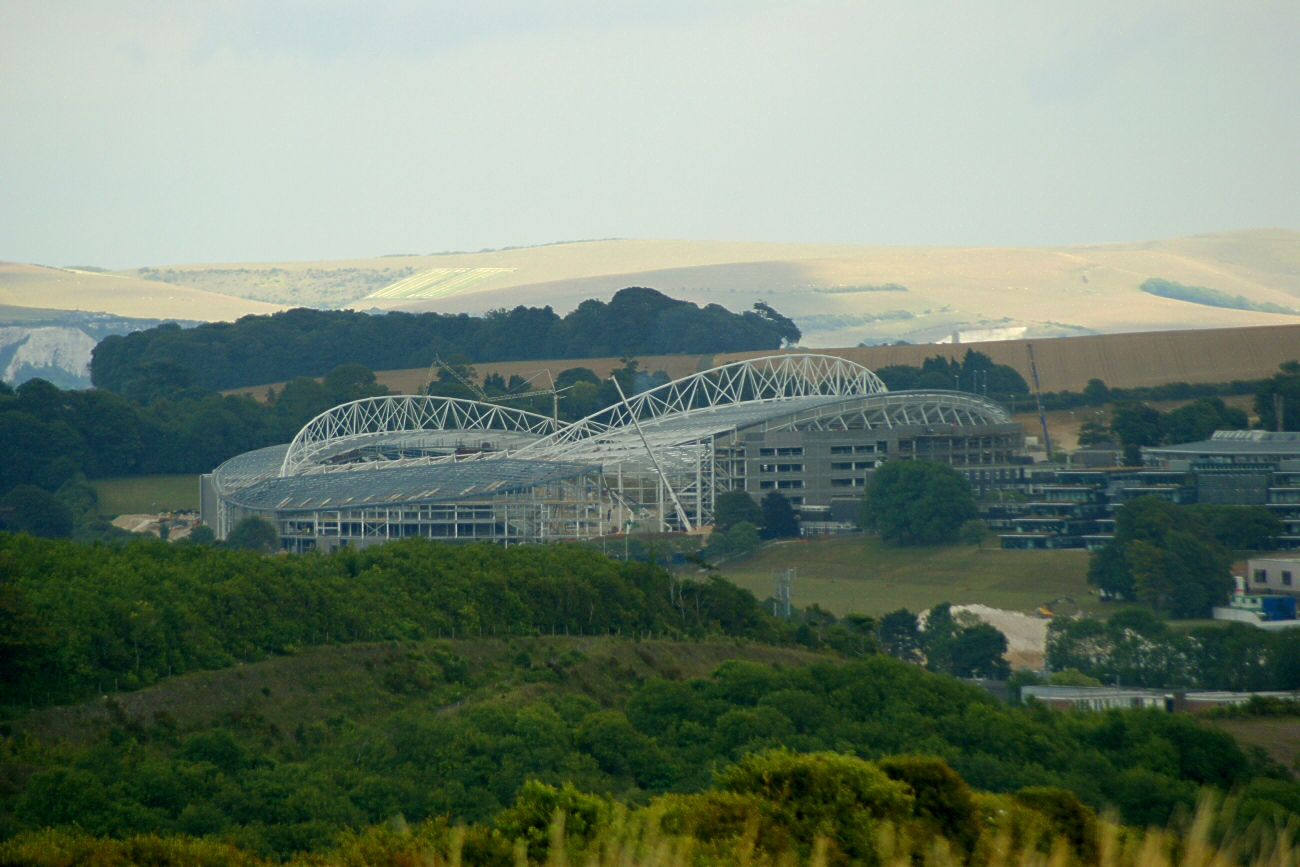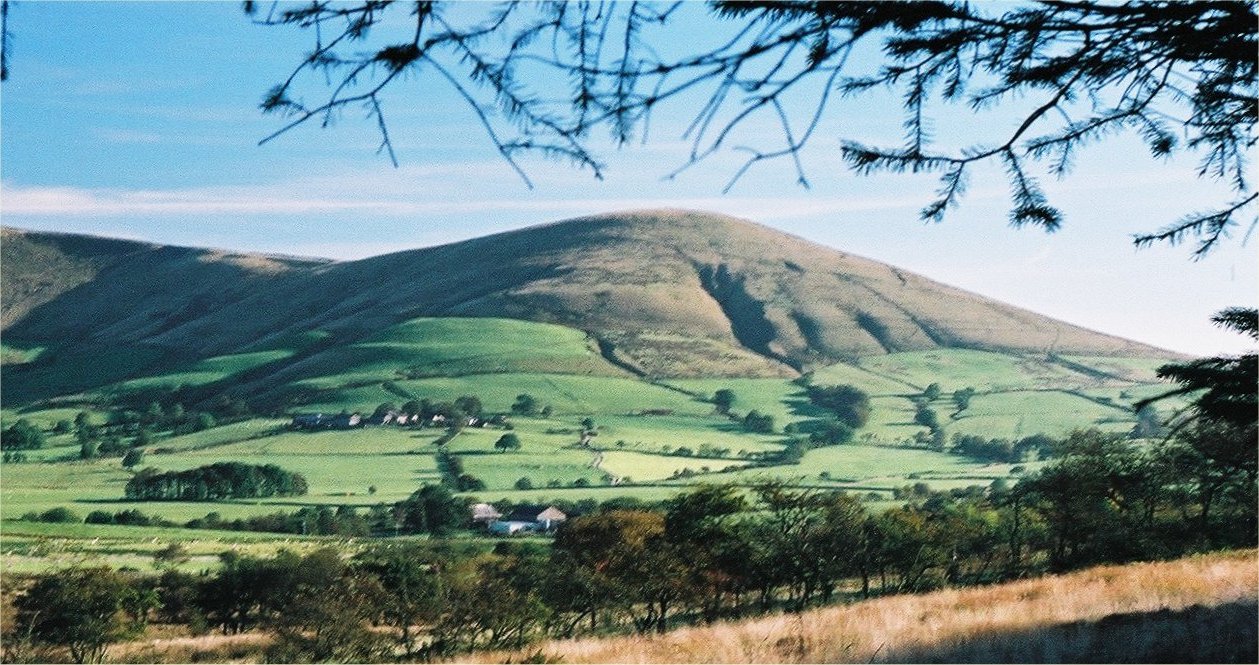|
Dunsop Bridge
Dunsop Bridge is a village in the civil parish of Bowland Forest High, in the borough of Ribble Valley, Lancashire, England, north-west of Clitheroe, south-east of Lancaster and west of Skipton. Historically, the village is part of the West Riding of Yorkshire, but was placed under the administration of Lancashire County Council on 1 April 1974. It is often cited as the geographic centre of Great Britain, although the exact point is at Whitendale Hanging Stones, near Brennand Farm, north of the village. In 1992, BT installed its 100,000th payphone at Dunsop Bridge and included a plaque to explain its significance. The telephone box was unveiled by Sir Ranulph Fiennes. In BT's A1141 list of unique alphabetical Telephone Exchange codes, the code for Dunsop Bridge is DSB. Geography The village is at the confluence of the River Dunsop and the River Hodder before the Hodder flows south to join the River Ribble outside Clitheroe. The bridge from which the village takes ... [...More Info...] [...Related Items...] OR: [Wikipedia] [Google] [Baidu] |
Bowland Forest High
Bowland Forest High is a civil parish in the Ribble Valley district of Lancashire, England, covering some of the Forest of Bowland. It fell within the ancient boundaries of the West Riding of Yorkshire. According to the 2001 census, the parish had a population of 163, falling to 144 at the 2011 Census. The parish includes the settlements of Hareden, Sykes, and Dunsop Bridge. It covers Sykes Fell, Whins Brow, Croasdale Fell and Wolfhole Crag. Before 1974, it formed part of Bowland Rural District in the West Riding of Yorkshire. History Historic Bowland comprised a Royal Forest and a Liberty of ten manors spanning eight townships and four parishes and covered an area of almost on the historic borders of Lancashire and Yorkshire. The manors within the Liberty were Slaidburn (Newton-in-Bowland, West Bradford, Grindleton), Knowlmere, Waddington, Easington, Bashall, Mitton, Withgill (Crook), Leagram (Bowland-with-Leagram), Hammerton and Dunnow (Battersby). Mode ... [...More Info...] [...Related Items...] OR: [Wikipedia] [Google] [Baidu] |
River Dunsop
The River Dunsop is a river in the Forest of Bowland in Northern England. It flows into the River Hodder at Dunsop Bridge. It begins at the confluence of the Brennand River and Whitendale River, both of which rise high up in the surrounding moorland. It then flows through the steep-sided Dunsop Valley before meeting the Hodder. An aqueduct carrying water to Blackburn runs alongside. The Dunsop drains a catchment approximately 9 km by 5 km, which comprises the sub-catchment areas of the Brennand and Whitendale, and is classed as a fifth order catchment. The catchment is primarily Millstone Grit, but the tributaries run through older shale and limestone strata On 8 August 1967 Dunsop Valley entered the UK Weather Records with the ''Highest 90-min total'' rainfall Rain is a form of precipitation where water droplets that have condensed from atmospheric water vapor fall under gravity. Rain is a major component of the water cycle and is responsible for deposit ... [...More Info...] [...Related Items...] OR: [Wikipedia] [Google] [Baidu] |
Historic Counties Of England
The historic counties of England are areas that were established for administration by the Normans, in many cases based on earlier Heptarchy, kingdoms and shires created by the Angles (tribe), Angles, Saxons, Jutes, Celts and the Danes (tribe), Danes and Norsemen, Norse in the North. They are alternatively known as ''ancient counties'', ''traditional counties'', ''former counties'' or simply as ''counties''. In the centuries that followed their establishment, as well as their administrative function, the counties also helped define local culture and identity. This role continued even after the counties ceased to be used for administration after the creation of Administrative counties of England, administrative counties in 1889, which were themselves amended by further local government reforms in the years following. Unlike the partly self-governing Ancient borough, boroughs that covered urban areas, the counties of medieval England existed primarily as a means of enforcing cent ... [...More Info...] [...Related Items...] OR: [Wikipedia] [Google] [Baidu] |
Wulfstan (died 956)
Wulfstan (died December 956) was Archbishop of York between 931 and 952. He is often known as Wulfstan I, to separate him from Wulfstan II, Archbishop of York. Early life Wulfstan was consecrated in 931.Fryde, et al. ''Handbook of British Chronology'' p. 224 He was presumably appointed with the consent of King Æthelstan, and attested all of the king's charters between 931 and 935. Between 936 and 41, however, he was absent from the king's court, for unknown reasons. Career Wulfstan's career is characterised by frequent swapping of allegiances, both among Viking leaders from Dublin and the Wessex kings. Perhaps Wulfstan played the part of 'king-maker' in Northumbrian politics in the mid-10th century, or perhaps he was guided by self-preservation and the interests of the Church in Northumbria.Downham ''Viking Kings of Britain and Ireland'' In 939, King Olaf Guthfrithson of Dublin invaded Northumbria and occupied York. King Edmund of England marched north to remove Olaf from ... [...More Info...] [...Related Items...] OR: [Wikipedia] [Google] [Baidu] |
Amounderness
The Amounderness Hundred ( ) is one of the six subdivisions of the historic county of Lancashire in North West England, but the name is older than the system of hundreds first recorded in the 13th century and might best be described as the name of a Norse wapentake. In the Domesday Book of 1086, it was used for some territories north of the River Ribble included together with parts of Yorkshire. The area eventually became part of Lancashire, sitting geographically between the Rivers Lune and Ribble, in the strip of coast between the Irish Sea and Bowland Forest. Etymology and history In the 19th century, the name was considered to have been first recorded in 705, as Hacmunderness. The Domesday Book in 1086 spells it Agemundrenessa. There are two suggested etymologies for Amounderness. The traditional 19th-century reading was that the name derived from ''ac'' (oak) and ''mund'' (protection), "a ness or promontory sheltered by oaks". This was given currency by Porter.Porter ... [...More Info...] [...Related Items...] OR: [Wikipedia] [Google] [Baidu] |
Lancaster Castle
Lancaster Castle is a medieval castle and former prison in Lancaster, Lancashire, Lancaster in the English county of Lancashire. Its early history is unclear, but it may have been founded in the 11th century on the site of a Roman fort overlooking a crossing of the River Lune. In 1164 the Honour of Lancaster, including the castle, came under royal control. In 1322 and 1389 the Scots invaded England, progressing as far as Lancaster and damaging the castle. It was not to see military action again until the English Civil War. The castle was first used as a prison in 1196 although this aspect became more important during the English Civil War. The castle buildings are owned by the Monarchy of the United Kingdom, British sovereign as Duke of Lancaster; part of the structure is used to host sittings of the Crown Court. Until 2011 the majority of the buildings were leased to the Ministry of Justice as His Majesty's Prison Service, HM Prison Lancaster, after which the castle was re ... [...More Info...] [...Related Items...] OR: [Wikipedia] [Google] [Baidu] |
Lancashire Witches
The trials of the Pendle witches in 1612 are among the most famous witch trials in English history, and some of the best recorded of the 17th century. The twelve accused lived in the area surrounding Pendle Hill in Lancashire, and were charged with the murders of ten people by the use of witchcraft. All but two were tried at Lancaster Assizes on 18–19 August 1612, along with the Samlesbury witches and others, in a series of trials that have become known as the Lancashire witch trials. One was tried at York Assizes on 27 July 1612, and another died in prison. Of the eleven who went to trial – nine women and two men – ten were found guilty and executed by hanging; one was found not guilty. The official publication of the proceedings by the clerk to the court, Thomas Potts, in his ''The Wonderfull Discoverie of Witches in the Countie of Lancaster'', and the number of witches hanged together – nine at Lancaster and one at York – make the trials unusual for England at that ... [...More Info...] [...Related Items...] OR: [Wikipedia] [Google] [Baidu] |
Area Of Outstanding Natural Beauty
An Area of Outstanding Natural Beauty (AONB; , AHNE) is one of 46 areas of countryside in England, Wales, or Northern Ireland that has been designated for conservation due to its significant landscape value. Since 2023, the areas in England and Wales have also adopted the name National Landscape (). Areas are designated in recognition of their national importance by the relevant public body: Natural England, Natural Resources Wales, and the Northern Ireland Environment Agency respectively. On 22 November 2023, following a review, the AONBs in England and Wales adopted the National Landscapes name, and are in the process of rebranding. AONBs in Northern Ireland did not rename. The name "area of outstanding natural beauty" is still the designated legal term. In place of the term AONB, Scotland uses the similar national scenic area (NSA) designation. Areas of Outstanding Natural Beauty enjoy levels of protection from development similar to those of UK national parks, but unli ... [...More Info...] [...Related Items...] OR: [Wikipedia] [Google] [Baidu] |
Forest Of Bowland
The Forest of Bowland, also known as the Bowland Fells and formerly the Chase of Bowland, is an area of gritstone fells, deep valleys and peat moorland, mostly in north-east Lancashire, England, with a small part in North Yorkshire (however roughly half of the area falls into the area of the historic West Riding of Yorkshire). It is a western outlier of the Pennines. The Forest of Bowland was designated an Area of Outstanding Natural Beauty (AONB) in 1964. The AONB also includes a detached part known as the Forest of Pendle separated from the main part by the River Ribble, Ribble Valley, and anciently a royal forest with its own separate history. One of the best-known features of the area is Pendle Hill, which lies in Pendle Forest. There are more than 500 listed buildings and 18 scheduled monuments within the AONB. The Trough of Bowland is a pass connecting the valley of the River Wyre, Marshaw Wyre with that of Langden Brook, and dividing the upland core of Bowland into two ... [...More Info...] [...Related Items...] OR: [Wikipedia] [Google] [Baidu] |
Rainfall
Rain is a form of precipitation where water droplets that have condensed from atmospheric water vapor fall under gravity. Rain is a major component of the water cycle and is responsible for depositing most of the fresh water on the Earth. It provides water for hydroelectric power plants, crop irrigation, and suitable conditions for many types of ecosystems. The major cause of rain production is moisture moving along three-dimensional zones of temperature and moisture contrasts known as weather fronts. If enough moisture and upward motion is present, precipitation falls from convective clouds (those with strong upward vertical motion) such as cumulonimbus (thunder clouds) which can organize into narrow rainbands. In mountainous areas, heavy precipitation is possible where upslope flow is maximized within windward sides of the terrain at elevation which forces moist air to condense and fall out as rainfall along the sides of mountains. On the leeward side of mountains, ... [...More Info...] [...Related Items...] OR: [Wikipedia] [Google] [Baidu] |
UK Weather Records
The United Kingdom weather records show the most extreme weather ever recorded in the United Kingdom, such as temperature, wind speed, and rainfall records. Reliable temperature records for the whole of the United Kingdom go back to about 1880. Records Daily records unless otherwise specified are from 0900-2100 UTC. As of 20 December 2022, the records, as recorded by the Met Office, are: Highest temperature by constituent country Earlier records for England/UK since 1911 are shown with a * in the "Top 10 hottest days" table below. Top 10 hottest days in the UK Starred entries signify the then-highest temperature recorded up to that date, until surpassed by the next starred date above. Lowest temperature by constituent country Most rainfall in periods of time Most hours of sunshine Highest wind speed Shetland holds the unofficial British record for wind speed. A gust of was reported on 1 January 1992. An earlier gust in 1962 was recorded at 177 mph (285 k ... [...More Info...] [...Related Items...] OR: [Wikipedia] [Google] [Baidu] |








